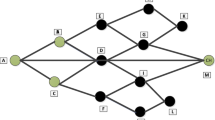Abstract
Wireless sensor networks (WSN) are expected to cover the major portion of the earth’s surface in the coming years. In the era of IoT, the WSN is the major data collection framework. To manage with the energy efficient data collection paradigm in WSN, numerous techniques have been suggested by the research community. In this paper, a data-aware energy conservation technique is proposed. Here, the inherent correlation between the consecutive observations of the sensor node and the data trend similarity between the neighboring sensor nodes are utilized to reduce the data transmission. A prediction-based data collection framework reduces the temporal data redundancy. ARIMA modeling is used to predict the data. The model is constructed by the (Clusterhead) CH node and is communicated to the cluster nodes. On every data collection round, the nodes compare the model predicted data and the observed data of the instant. If there is a deviation beyond the specified threshold, the nodes communicate the data difference to the CH. The data differences collected by the CH are compressed by using PCA technique. The compressed data are then sent to the sink node. Using this method, a huge portion of redundant data transmission is cut off. The method also maintains the collected data’s accuracy within the predefined error threshold. Being a data reduction-based energy conservation technique, this results in reduced data collision. This method conserves 82% of energy with the error threshold of minimum level.









Similar content being viewed by others
References
Mao S et al (2014) Joint energy allocation for sensing and transmission in rechargeable wireless sensor networks. IEEE Trans Veh Technol 63(6):2862–2875
Hong YW, Scaglione A (2006) Energy-efficient broadcasting with cooperative transmissions in wireless sensor networks. IEEE Trans Wirel Commun 5(10):2844–2855
Elhoseny M et al (2015) Balancing energy consumption in heterogeneous wireless sensor networks using genetic algorithm. IEEE Commun Lett 19(12):2194–2197
Cheng VW, Wang TY (2010) Performance analysis of distributed decision fusion using a censoring scheme in wireless sensor networks. IEEE Trans Veh Technol 59(6):2845–2851
Rago C, Willett PK, Bar-Shalom Y (1996) Censoring sensors: a low-communication-rate scheme for distributed detection. IEEE Trans Aerosp Electron Syst 32(2):554–568
Jiang R, Chen B (2005) Fusion of censored decisions in wireless sensor networks. IEEE Trans Wireless Commun 4(6):2668–2673
Pai H-T (2000) Equal-gain combination for adaptive distributed classification in wireless sensor networks. Int J Ad Hoc Ubiquitous Comput 4(2):115–121
Cetin M, Chen L, Fisher JW III, Ihler AT, Moses RL, Wainwright MJ, Willsky AS (2006) Distributed fusion in sensor networks: a graphical models perspective. IEEE Signal Process Mag 23(4):42–55
Yiu S, Schober R (2009) Nonorthogonal transmission and noncoherent fusion of censored decisions. IEEE Trans Veh Technol 58(1):263–273
Krause A, Singh A, Guestrin C (2008) Near-optimal sensor placements in Gaussian processes: theory, efficient algorithms and empirical studies. J Mach Learn Res 9:235–284
Pukelsheim F (2006) Optimal design of experiments. Society for Industrial and Applied Mathematics, Philadelphia
Msechu EJ, Giannakis GB (2011). Distributed measurement censoring for estimation with wireless sensor networks. In: IEEE 12th International Workshop on Signal Processing Advances in Wireless Communications
Appadwedula S, Veeravalli VV, Jones DL (2008) Decentralized detection with censoring sensors. IEEE Trans Signal Process 56:1362–1373
Rago C, Willett P, Bar-Shalom Y (1996) Censoring sensors: a low-communication-rate scheme for distributed detection. IEEE Trans Aerosp Electron Syst 32:554–568
Wang H et al (2008) Network lifetime maximization with cross-layer design in wireless sensor networks. IEEE Trans Wirel Commun 7(10):3759–3768
Wei G, Ling Y, Guo B, Xiao B, Vasilakos AV (2011) Prediction-based data aggregation in wireless sensor networks: combining grey model and Kalman Filter. Comput Commun 34(6):793–802
Zhang B et al (2013) An energy efficient sampling method through joint linear regression and compressive sensing. In: Intelligent Control and Information Processing (ICICIP), Fourth International Conference on. IEEE
Tharini C, Ranjan PV (2011) An energy efficient spatial correlation based data gathering algorithm for wireless sensor networks. Int J Distrib Parallel Syst 2(3):16–24
Yoon S, Shahabi C (2007) The clustered aggregation (CAG) technique leveraging spatial and temporal correlations in wireless sensor networks. ACM Trans Sens Netw (TOSN) 3(1):3
Masiero R, Quer G, Munaretto D, Rossi M, Widmer J, Zorzi M (2009, November) Data acquisition through joint compressive sensing and principal component analysis. In: Global Telecommunications Conference, 2009. GLOBECOM 2009. IEEE, pp 1–6
Macua SV, Belanovic P, Zazo S (2010, June) Consensus-based distributed principal component analysis in wireless sensor networks. In: Signal Processing Advances in Wireless Communications (SPAWC), 2010 IEEE Eleventh International Workshop on. IEEE, pp 1–5
Le Borgne YA, Raybaud S, Bontempi G (2008) Distributed principal component analysis for wireless sensor networks. Sensors 8(8):4821–4850
Author information
Authors and Affiliations
Corresponding author
Rights and permissions
About this article
Cite this article
Diwakaran, S., Perumal, B. & Vimala Devi, K. A cluster prediction model-based data collection for energy efficient wireless sensor network. J Supercomput 75, 3302–3316 (2019). https://doi.org/10.1007/s11227-018-2437-z
Published:
Issue Date:
DOI: https://doi.org/10.1007/s11227-018-2437-z




